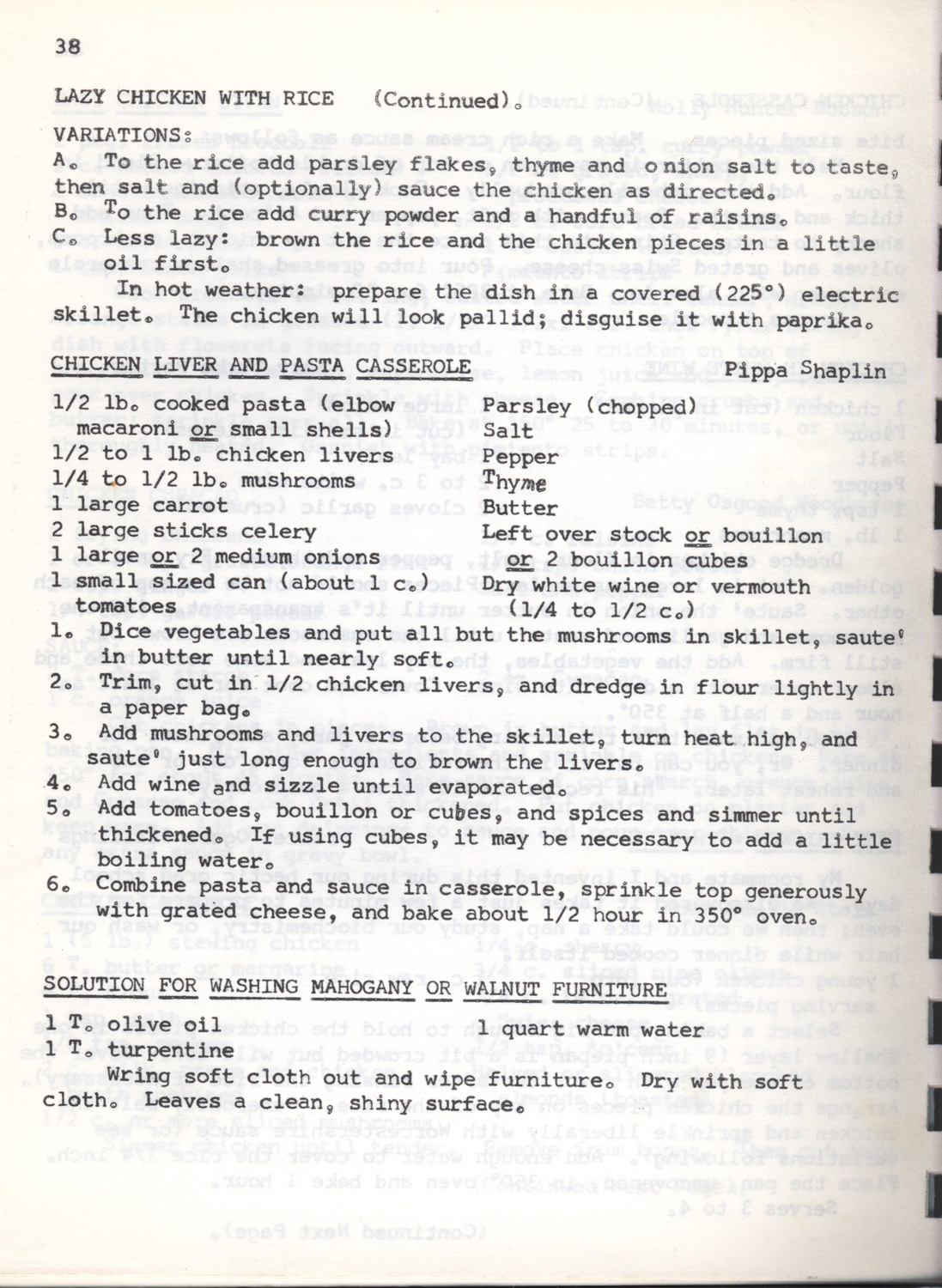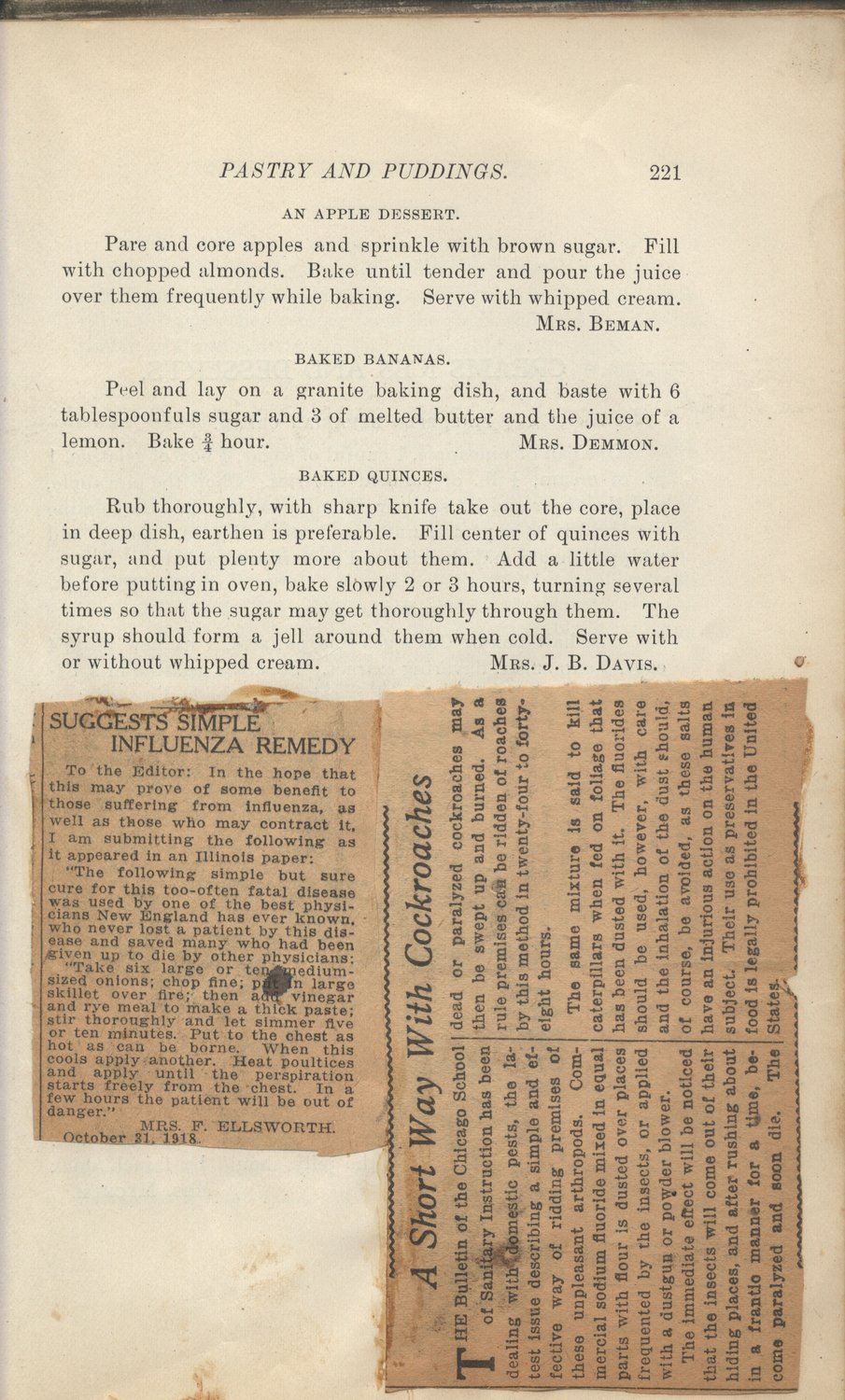Creative Cookery

Cookery means carefulness, willingness, daring-inventiveness, readiness of equipment and appliances. It means the economy of your grandmothers', the science of modern chemists; it means much testing and no wasting; it means patience, and patience some more; it means the love for cooking; enticing the family to proper tantalizing meals and foods; centering the life of the family around the kitchen; with English thoroughness, French Art, Irish wit, German rivalry, Spanish struggle, Italian achievements, Bohemian determination, American advancements and Arabian hospitality.
SOLUTION FOR WASHING MAHOGANY OR WALNUT FURNITURE

1 t. olive oil
1 quart warm water
1 t. turpentine
Wring soft cloth out and wipe furniture. Dry with soft cloth. Leaves a clean, shiny surface.
TO COLOR FRUIT YELLOW

Boil the fruit with fresh skin lemons in water to cover them, until it is tender; then take it up, spread it on dishes to cool, and finish as may be directed.
TO COLOR PRESERVES PINK

By putting in with it a little cochineal powdered fine; then finish in the syrup.
TO GREEN FRUIT FOR PRESERVING IN SUGAR OR VINEGAR

Apples, pears, limes, plums, apricots, etc., for preserving or pickling, may be greened thus: Put vine-leaves under, between, and over the fruit in a preserving kettle; put small bits of alum, the size of a pea, say 8 dozen bits to a kettleful; put enough water to cover the fruit, cover the kettle close to exclude all outer air, set it over a gentle fire, let them simmer; when they are tender drain off the water; if they are not a fine green let them become cold, then put vine-leaves and a bit of saleratus or soda with them, and set them over a slow fire until they begin to simmer; a bit of soda or saleratus the size of a small nutmeg will have the desired effect; then spread them out to cool, after which finish as severally directed.
BRINE THAT PRESERVES BUTTER A YEAR

To three gallons of brine strong enough to bear an egg, add one quarter pound good loaf sugar, and one tablespoonful of salt petre; boil the brine, and when it is cold strain carefully. Pack butter closely in small jars, and allow the brine to cover the butter to the depth of at least four inches. This completely excludes the air. If practicable make your butter into small rolls, wrap each carefully in a clean muslin cloth, tying up with a string; place a weight over the butter to keep it all submerged in the brine. This mode is most recommended by those who have tried both.
PUDDINGS

GENERAL REMARKS. All boiled puddings should be put on in boiling water. which must not be allowed to stop simmering, and the pudding must always be covered with the water; if requisite the saucepan should be kept filled up. To prevent a pudding boiled in a cloth from sticking to the bottom of the saucepan, place a small plate or saucer underneath it, if a mold is used, this precaution is not necessary; but care must be taken to keep the pudding well covered with water. For dishing a boiled pudding as soon as it comes out of the pot, dip it into a basin of cold water, and the cloth will then not adhere to it. Great expedition is necessary in sending puddings to table, as, by standing, they quickly become heavy, batter puddings particularly. For baked or boiled puddings, the molds, cups, or basins should be always buttered before the mixture is put in them, and they should be put into the saucepan directly they are filled.
ICELAND MOSS.

Take 1 oz. Iceland moss, wash and boil in 1 qt. water until it is reduced to 1 pt. Then strain and add 1 lb. white sugar and the juice of 2 lemons. Very palatable, and can be used as freely as desired. Excellent for a cough.
SIMPLE INFLUENZA REMEDY

To the Editor: In the hope that this may prove of some benefit to those suffering from influenza, as well as those who may contract it. I am submitting the following as it appeared in an Illinois paper: The following simple but sure cure for this too-often fatal disease was used by one of the best physicians New England has ever known. who never lost a patient by this disease and saved many who had been given up to die by other physicians: "Take six large or ten medium-sized onions; chop fine; then large skillet over fire; then add vinegar and rye meal to make a thick paste; stir thoroughly and let simmer five or ten minutes. Put to the chest as hot as can be borne. When this cools apply another. Heat poultices and apply until the perspiration starts freely from the chest. In a few hours the patient will be out of danger." October 21, 1918.
To Preserve Vegetables for Winter Use

Green stringed beans must be picked when young; put a layer three inches deep in a small wooden keg or half barrel; sprinkle in salt an inch deep, then put another layer of beans, then salt, and beans and salt in alternate layers, until you have enough; let the last be salt; cover them with a piece of board which will fit the inside of the barrel or keg, and place a heavy weight upon it; they will make a brine.
When wanted for use, soak them one night or more in plenty of water, changing it once or twice, until the salt is out of them, then cut them, and boil the same as when fresh. Carrots, beans, beet-roots, parsnips, and potatoes keep best in dry sand or earth in a cellar; turnips keep best on a cellar bottom, or they may be kept the same as carrots, etc. Whatever earth remains about them when taken from the ground, should not be taken off.
When sprouts come on potatoes or other stored vegetables, they should be carefully cut off. The young sprouts from turnips are sometimes served as a salad, or boiled tender in salt and water, and served with butter and pepper over.
Celery may be kept all winter by setting it in boxes filled with earth; keep it in the cellar; it will grow and whiten in the dark; leeks may also be kept in this way.
Cabbage set out in earth, in a good cellar, will keep good and fresh all winter. Small close heads of cabbage may be kept many weeks by taking them before the frost comes, and laying them on a stone floor; this will whiten them, and make them tender.
Store onions are to be strung, and hung in a dry, cold place.